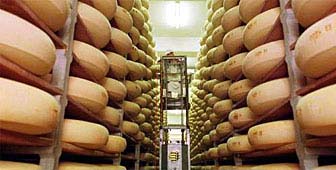When American cheese makers taste real Emmental

Does fur fly when American makers of low-cost Swiss-style cheese meet the makers of that stalwart of the Helvetian cheese making tradition, Emmental?
Given that the US-made product costs about half as much as the original, and looks pretty similar to it – holes and all – the Swiss would be forgiven for harbouring hostile feelings towards those who could be seen as pricing them out of the market.
The two camps came together recently at a musical dinner party organised at a typical restuarant in the Bernese Oberland.
As the American guests tasted the original Swiss fondue, the atmosphere was not quite as frosty as might have been expected from those engaged in what might be termed a holey war.
“It’s ganz gut…”, said Arlene as she gleefully plunged her fork into the bubbling cheese. “But I probably couldn’t tell the difference between this and what we eat back home!”
Stephanie was better at discerning the nuances between cheeses made on different continents: “Your cheese has a stronger taste, ours in America is less flavourful. I had never tasted fondue, but this is real good.”
As for Sue, a cheese retailer, her comment was simply: “This is very excellent. Different, but very excellent.”
Contrary to expectations, the Emmental makers and the American producers of the Swiss-style cheese are not at war with each other. The simple reason is that the cheeses they make fall into two very distinct categories.
Anton Schmutz is the director of Käsekunst, Switzerland’s association for traditional cheese making: “It’s a different product; we use raw milk, versus pasteurised – which needs a shorter time to mature,” he said.
“Emmental has a special taste, it’s natural and has no additives. The milk comes from cows that are fed naturally, not on silage” (a type of fermentation feed on which many American herds are fed).
Emmental is made by artisans, costs twice as much as its American imitation, and is sold as a gourmet product.
Swiss-style cheese – which is how cheese with holes is termed in the US – has no rind, is made in blocks (not giant wheels) and comes in two versions: Swiss and Baby-Swiss.
The splendidly named latter is higher in fat content and is easier to slice, because it has smaller holes – or eyes, as they’re officially known.
Different people buy the cheeses for different reasons. Steve Stettler is the president of the Wisconsin Cheese Makers Association, or WCMA, and believes the extra cost incurred by the weight of the rind affects the price-conscious shopper.
“I have a little cheese store, and the average housewife will not pay extra for Emmental because it has a rind,” he said as Schmutz and his village band struck up a typical Alpine tune for their foreign guests.
“But her husband will want to buy it because of the greater flavour. So, you even have discrepancies within households!” he continued with a chuckle.
Last year Emmental cheese makers lost the government subsidies they had long received for making the traditional product. The move caused 50 out of a total of 400 dairies to go out of business. Worse still, another 200 are expected to go under in the coming years.
Schmutz, however, believes there will always be a market for the original Swiss cheese, even if it costs far more than other similar products.
“We must focus on quality, not price,” he said confidently, adding that he would not be swayed by his American counterparts’ suggestions that if Emmental makers were to scrap their giant cheese wheels – in favour of giant rectangular cheese blocks – they would increase sales.
“It’s easier to make blocks, because the cheese can mature in film, and provides less work, he explained. “Many countries do it, but we don’t need to copy them. The price would then be far too low for the quantities we produce.”
The American-made Swiss cheese is only sold in the US. Sensibly, the WCMA has no intention of entering the Swiss market. Emmental makers, on the other hand, sell a lot of their cheese to the Americans. Is it not misleading for the American-made product to be called Swiss?
John Umhofer is the executive director of the WCMA: “We’re honest, we don’t claim to make the cheese in Switzerland. Unfortunately, though, the generic term is out of the barn, and it has been used for decades.”
Schmutz says it was a great mistake that in the old days the Swiss didn’t have the presence of mind to try to protect the name. But he says Emmental does have plans to emphasise its originality more in its transatlantic marketing campaigns.
Meanwhile, though, he just has to hope enough consumers will continue to let their taste buds, not simply their wallets, determine which cheese to buy. And that they’ll continue to view cheese coming from a block as incongruous as, say, making Swiss cheese with square eyes.
by Juliet Linley

In compliance with the JTI standards
More: SWI swissinfo.ch certified by the Journalism Trust Initiative
You can find an overview of ongoing debates with our journalists here. Please join us!
If you want to start a conversation about a topic raised in this article or want to report factual errors, email us at english@swissinfo.ch.